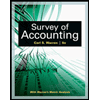
a. (1)
Compute the
a. (1)
Explanation of Solution
Current ratio: Current ratio is one of the
Compute current ratio for Company K and Incorporation WF.
| Ratios and Formula | Company K | Incorporation WF |
|
(1) Current ratio: |
Table (1)
a. (2)
Compute the average days to sell inventory ratio for Company K and Incorporation WF for the fiscal year 2014.
a. (2)
Explanation of Solution
Average days to sell inventory: This ratio is determined as the number of days a particular company takes to make sales of the inventory available with them. It is calculated by using the formula:
Compute average days to sell inventory for Company K and Incorporation WF:
| Ratios and Formula | Company K | Incorporation WF |
|
Average days to sell inventory: |
Table (2)
Working Note:
Determine the average inventory for both the companies.
| Ratios and Formula | Company K | Incorporation WF |
|
Inventory turnover: Average inventory: |
|
|
Table (3)
a. (3)
Compute the debt to assets ratio for Company K and Incorporation WF for the fiscal year 2014.
a. (3)
Explanation of Solution
Debt to assets ratio: The debt to asset ratio shows the relationship between total asset and the total liability of the company. Debt ratio reflects the financial strategy of the company. It is used to measure the percentage of company’s assets that are financed by long term debts. Debt to assets ratio is calculated by using the formula:
Compute debt to assets ratio for Company K and Incorporation WF:
| Ratios and Formula | Company K | Incorporation WF |
|
Debt to assets ratio: |
Table (4)
a. (4)
Compute the
a. (4)
Explanation of Solution
Return on investment (assets): Return on investments (assets) is the financial ratio which determines the amount of net income earned by the business with the use of total assets owned by it. It indicates the magnitude of the company’s earnings with relative to its total assets. Return on investment is calculated as follows:
Compute return on investment for Company K and Incorporation WF:
| Ratios and Formula | Company K | Incorporation WF |
|
Return on investment: |
Table (4)
Working note:
Determine the average total assets for both the companies.
| Ratios and Formula | Company K | Incorporation WF |
|
Average total assets: |
Table (5)
a. (5)
Compute the gross margin percentage for Company K and Incorporation WF for the fiscal year 2014.
a. (5)
Explanation of Solution
Gross margin percentage: It is one of the profitability ratios. Gross margin ratio is used to measure the percentage of gross profit that is being generated per dollar of revenue or sales. It is calculated by using the formula:
Compute gross margin percentage for Company K and Incorporation WF:
| Ratios and Formula | Company K | Incorporation WF |
|
Gross margin percentage: |
Table (6)
a. (6)
Compute the asset turnover for Company K and Incorporation WF for the fiscal year 2014.
a. (6)
Explanation of Solution
Asset turnover: Turnover of assets is a ratio that measures the productive capacity of the total assets to generate the sales revenue for the company. Thus, it shows the relationship between the net sales and the average total assets. Turnover of assets is calculated as follows:
Compute asset turnover for Company K and Incorporation WF:
| Ratios and Formula | Company K | Incorporation WF |
|
Asset turnover: |
|
Table (7)
Working note:
Determine the average total assets for both the companies.
| Ratios and Formula | Company K | Incorporation WF |
|
Average total assets: |
Table (8)
a. (7)
Compute the net margin for Company K and Incorporation WF for the fiscal year 2014.
a. (7)
Explanation of Solution
Net margin: It is one of the profitability ratios. Net margin ratio is used to measure the percentage of net income that is being generated per dollar of revenue or sales. It is calculated by using the formula:
Compute net margin for Company K and Incorporation WF:
| Ratios and Formula | Company K | Incorporation WF |
|
Net margin: |
Table (9)
a. (7)
Compute plant to long term debt ratio for Company K and Incorporation WF for the fiscal year 2014.
a. (7)
Explanation of Solution
Plant assets to long term debt: Plant assets to long term debt ratio measure the value of assets per each dollar of long term liabilities. It is calculated by using the formula:
Compute plant to long term debt ratio for Company K and Incorporation WF:
| Ratios and Formula | Company K | Incorporation WF |
|
Plant assets to long-term debt: |
Table (10)
b.
Identify the company that appears to be more profitable. Identify the ratio that reveals the profitability using requirement a. and justify the conclusion.
b.
Explanation of Solution
The ratios that are most relevant for determining profitability are as follows:
- 1) Return on investment: Return on investments (assets) is the financial ratio which determines the amount of net income earned by the business with the use of total assets owned by it. It indicates the magnitude of the company’s earnings with relative to its total assets.
- 2) Net margin: It is one of the profitability ratios. Profit margin ratio is used to measure the percentage of net income that is being generated per dollar of revenue or sales.
As per Table (1), the return on investment and net margin of Incorporation WF is 16.8% and 6.67% respectively, which is substantially higher than the profitability ratios of Company K.
c.
Identify the company that has higher level of financial risk. Identify the ratio that reveals the financial risk using requirement a. and justify the conclusion.
c.
Explanation of Solution
The ratios that are most relevant for determining profitability are as follows:
- 1) Current ratio: Current ratio is one of the liquidity ratios, which measures the capacity of the company to meet its short-term obligations using its current assets.
- 2) Debt to assets ratio: The debt to asset ratio shows the relationship between total asset and the total liability of the company. Debt ratio reflects the financial strategy of the company. It is used to measure the percentage of company’s assets that are financed by long term debts.
- 3) Plant assets to long term debt: Plant assets to long term debt ratio measure the value of assets per each dollar of long term liabilities.
As per Table (1), the current ratio, Debt to assets ratio and plant assets to long term debt of Incorporation WF is 1.40:1, 33.6% and 4.3:1 respectively, which indicates that Incorporation WF is having higher level of financial risk .
d.
Identify the company that charges higher prices for the goods. Identify the ratio that reveals the information using requirement a. and justify the conclusion.
d.
Explanation of Solution
The ratios that are most relevant for determining the cost of goods of both the companies is the gross margin percentage. The gross margin ratio is used to measure the percentage of gross profit that is being generated per dollar of revenue or sales. The gross margin of Incorporation WF is 35.5% which is significantly higher than Company K. The higher gross margin indicates that Incorporation WF is charging the most of its goods with respect to what it pays for the items it sells.
e.
Identify the company that is efficiently using its assets. Identify the ratio that reveals the profitability using requirement a. and justify the conclusion.
e.
Explanation of Solution
The ratios that are most relevant for determining the efficient utilization of assets are as follows:
- 1) Average days to sell inventory: This ratio is determined as the number of days a particular company takes to make sales of the inventory available with them.
- 2) Asset turnover: Turnover of assets is a ratio that measures the productive capacity of the total assets to generate the sales revenue for the company. Thus, it shows the relationship between the net sales and the average total assets
As per Table (1), the average days to sell inventory of Incorporation WF is 17 days which indicates that Incorporation WF is utilizing the inventory efficiently than Company K. However, the asset turnover of Company K is 3.62 times, whereas of Incorporation WF the asset turnover ratio is 2.5 times, that indicates the efficiency of Company K to earn higher turnover using its total assets.
Want to see more full solutions like this?
Chapter 9 Solutions
SURVEY OF ACCOUNT.(LL)-W/ACCESS>CUSTOM<
- I need help solving this general accounting question with the proper methodology.arrow_forwardCan you help me solve this general accounting problem using the correct accounting process?arrow_forwardPlease provide the accurate answer to this general accounting problem using valid techniques.arrow_forward
 Financial Accounting: The Impact on Decision Make...AccountingISBN:9781305654174Author:Gary A. Porter, Curtis L. NortonPublisher:Cengage Learning
Financial Accounting: The Impact on Decision Make...AccountingISBN:9781305654174Author:Gary A. Porter, Curtis L. NortonPublisher:Cengage Learning Cornerstones of Financial AccountingAccountingISBN:9781337690881Author:Jay Rich, Jeff JonesPublisher:Cengage LearningPrinciples of Accounting Volume 2AccountingISBN:9781947172609Author:OpenStaxPublisher:OpenStax College
Cornerstones of Financial AccountingAccountingISBN:9781337690881Author:Jay Rich, Jeff JonesPublisher:Cengage LearningPrinciples of Accounting Volume 2AccountingISBN:9781947172609Author:OpenStaxPublisher:OpenStax College Survey of Accounting (Accounting I)AccountingISBN:9781305961883Author:Carl WarrenPublisher:Cengage Learning
Survey of Accounting (Accounting I)AccountingISBN:9781305961883Author:Carl WarrenPublisher:Cengage Learning AccountingAccountingISBN:9781337272094Author:WARREN, Carl S., Reeve, James M., Duchac, Jonathan E.Publisher:Cengage Learning,
AccountingAccountingISBN:9781337272094Author:WARREN, Carl S., Reeve, James M., Duchac, Jonathan E.Publisher:Cengage Learning, College Accounting, Chapters 1-27AccountingISBN:9781337794756Author:HEINTZ, James A.Publisher:Cengage Learning,
College Accounting, Chapters 1-27AccountingISBN:9781337794756Author:HEINTZ, James A.Publisher:Cengage Learning,





